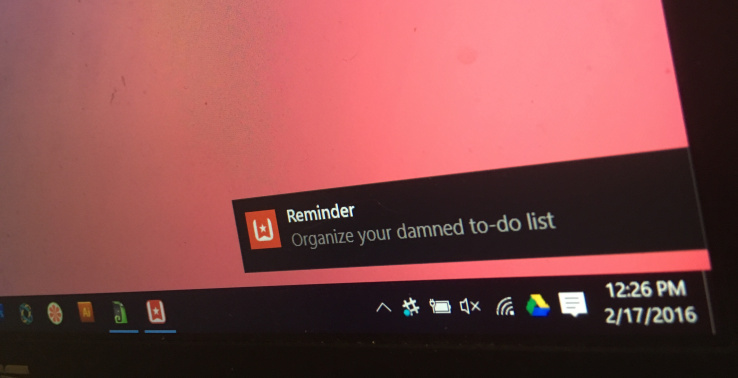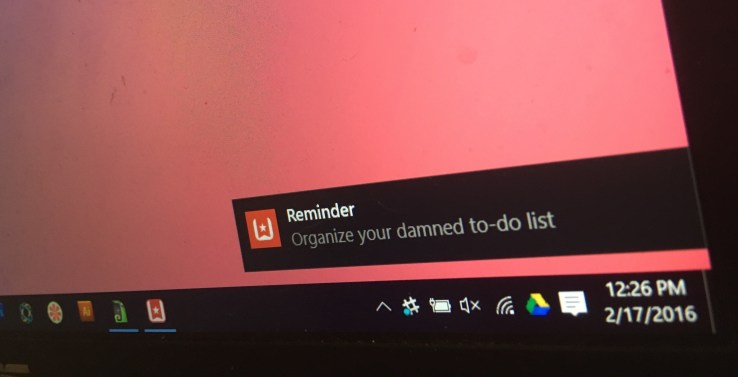

I’ve spent the past month in a daze, trying to make sense of my own tasks and responsibilities while forcing myself to adhere to a system I came up with that simply doesn’t work.
You can never anticipate how your “perfectly designed” task-management system can fail. It’s our own nature — we’re so sure of ourselves — that makes us think our idea will be the magic trick that solves all our problems.
For me, this idea came around a month ago, on a rainy street in a cafe mostly filled with elderly ladies, looking at me disapprovingly while I did nothing but scroll on my phone for two hours solid. Frustrated with the way I organize my reminders, I was looking for a way to solve the problem that didn’t involve using 50 different apps.
Instead, I ended up creating systems that would bring tears of laughter to the eyes of anyone who knew the first thing about productivity.
When I got home to my laptop, I wrote an awful 2,000-word article about it. Thankfully, this isn’t that article. It probably won’t see the light of day — it’s too angry and incoherent to share with anyone.
After some time to reflect and apply rational thought to the situation, I’m here, in the midst of a symphony of push notifications, writing this instead. I’m going to talk about my fight against Twitter and my failing productivity, the apps and systems with which I’ve tried to keep myself in check and the psychology behind why we build an aversion against getting things done.
Trying solve 10 problems with 10 apps
The way I used to organize my whole working life was with Trello. It seemed ideal, at first. You’ve got one card per quantifiable task that moves around the board depending on its status. It’s not like I let tasks stack up, but the amount of places from which Trello gets data (using workflow automation software like Zapier) means that it’s full of cards I don’t know how to deal with. It’s like layering your office wall with sticky notes and not having a clue which one to pull off and read first.
A problem with all productivity apps is that they need upkeep. Apps can’t just make you productive by the fact that they exist; you must use them, maintain them and put in effort to get results.
Many productivity apps can help you organize your life as a secondary function to their main purpose:
-
Evernote can be turned into a to–do list, as well as being the permanent home for all your quick notes, a writing workflow tool or a scrapbook for your receipts.
-
Trello can notify you of upcoming deadlines, and store your tasks, files and communications.
-
Slack can act as a reminder-bot, parsing natural language into concrete reminders at real dates and times.
-
WorkFlowy is a zoomable document that is great for taking notes and structuring projects — and it doubles as a task-management system.
The problem with this is that unless you go all or nothing with one app, you’re scattered between numerous different systems, some with push notifications, some with email summaries, some synced to your calendar, etc.
Spending your time maintaining a needlessly complex system instead of doing work that matters is a huge productivity killer, one that I’ve been trying (and failing) to fight simply because I use too many apps that don’t do enough.
To-do list apps help you form habits of ignorance, where Twitter forms an addiction
We have an aversion to getting told what to do versus getting told we’re being talked about. The phone buzzes over the other side of the room. I use my laptop to check my emails for a reply from an editor. Nothing. I check Twitter to see if someone’s approving of my life choices. Nothing. I resolve it’s some kind of non-essential deadline coming nearer, and, out of defense, don’t check it, getting on with whatever I’m trying too hard to focus on.
Like a lot of other aspects of life, we’ve been conditioned to only hear what we want to hear. I don’t want to know it’s time to get up, break my concentration and hoover the bloody house; although, paradoxically, I’d love my concentration to be broken if it would only inform me of a retweet.
The psychology of notifications
In their article The Psychology of Notifications, Ximena Vengochea and Nir Eyal call notifications “the Pavlovian bell of the 21st century.” For app designers and users alike, this is a double-edged sword. While notifications are exciting and a way to engage users repeatedly, they’re also numbing. When half of your notifications aren’t relevant and you’re waiting for an important reply, it can be like getting phone calls from everyone but the pizza delivery guy.
Notifications kill our ability to do focus work
I work remotely with a huge degree of freedom. I have a few set weekly deadlines, but other than that I’m free to work in a way any boss with an understanding of how creativity works would allow — of my own accord, writing as and when I feel like it.
Even though it kills my productivity, I’m a sucker for push notifications.
A research paper published by Florida State University tested students’ reactions to a simple game against a group that played the same game but had audible notifications distracting them as they went. Even though the participants never acted on the notifications, the test indicated that the notification sounds or vibrations distracted them noticeably, and just as much as a phone call would.
When it comes to it, and I have an idea I have to write down, I want to do that and only that. If I was working in an office (something I’ve only ever done for three months of my life), then my time I spend with tunnel vision in a text editor would be the time someone doesn’t let any calls come into my office. Why, then, do I think it’s okay to have a chiming phone going off every few minutes?
How to solve it
I don’t think it’s okay to be bombarded with notifications, I’m just lazy. Swiping away every notification that comes in is irritating, but not enough of an involved task to force me to take meaningful action, which is a problem.
Just like how I probably dismiss that Java update dialog box several times a week, it becomes a muscle memory reflex to dismiss notifications without consciously registering them.
A way to solve this is by prioritizing just two tasks on your list every day, and removing reminders for the rest. In an app that lets you create multiple lists and mark labels or star tasks (such as Trello, Wunderlist or Todoist), you can have your “today” list and your “backlog” list to keep only the most important tasks on the top of your mind. From that, you can add reminders for only the tasks that are important and urgent.
When I started with Wunderlist, I set myself daily recurring tasks for every little thing I can think of — process reminders, inbox zero, wash the pans. Even now I haven’t restructured yet because it’s easier to sit through a stream of ignorable notifications than to sit down and change the system.
There’s going to come a point where I ask myself if I really need to process my Evernote inbox or items saved to Pocket twice every week, or whether it’s something I should do when I actually have the time to do it. Because right now, getting bugged about it regularly by my phone has given me an aversion to it completely.
Just disable them?
An obvious solution is to cut push notifications out of your life completely. Owen Williams’ intriguing study into his own psychology of app overload concluded with him deciding to get rid of Twitter on his phone and only check the inferior web-based version.
I’m not strong enough for that yet. Even though it kills my productivity, I’m a sucker for push notifications and will hold onto the silly hope that something interesting just happened to me. As I typed that last sentence, I stopped midway through to check my phone — mere seconds away from going into glazed-eyes-Twitter-scrolling mode.

